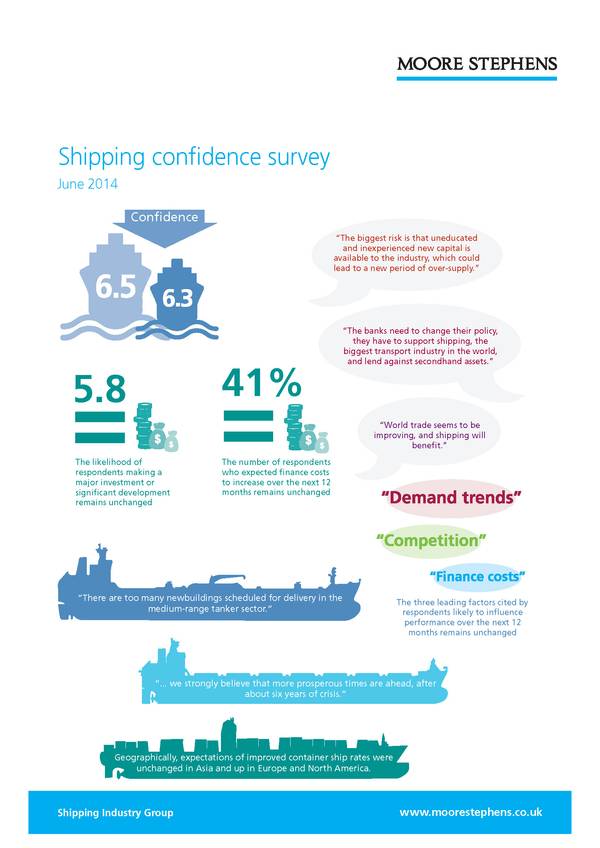
Overall confidence levels in the shipping industry fell slightly during the time span between March and May. Though, they remain at their second-highest level over the past six years, according to the latest Shipping Confidence Survey provided by Moore Stephens. Expectations of new investment were maintained over the three-month period, but the prospect for higher freight rates softened in the tanker and dry bulk sectors. Uncertainty over the likely effect of an increase in private equity funding, and the consequent potential impact on tonnage supply dominated the thoughts of survey respondents.
In May 2014, the average confidence level expressed by respondents in the markets in which they operate was 6.3 on a scale of 1 (low) to 10 (high), compared to the 6.5 recorded in February 2014—the highest figure since 2008.
Ship managers were the only category of main respondent to report an increase in confidence. Owners, charterers and brokers were less confident than they were three months previously.
Geographically, confidence was stable in Asia at 6.4, but down in Europe and in North America, from 6.4 to 6.2 and from 7.1 to 6.5 respectively.
Despite the overall decline in confidence levels, a number of survey respondents remained upbeat. “Levels of confidence are good, and are expected to improve,” said one, while another noted, “World trade seems to be improving, and shipping will benefit.”
Others were slightly more guarded in their responses. One said, “The market is improving, but there are still some smaller, financially weak companies likely to go bust.” Another observed, “We have noted slight improvements in the market and are confident that more significant growth will take place in the coming months,”
Concern about overtonnaging, meanwhile, continued apace. “The market is a little more stable, said one respondent, “but we need to stop ordering newbuildings, particularly in the medium-range tanker and platform supply vessel sectors.”
The increasing availability of non-traditional ship finance, and of private equity funding in particular, dominated the thoughts of a number of respondents. One said, “The biggest risk is that uneducated and inexperienced new capital is available to the industry, which could lead to a new period of over-supply.”
Moore Stephens shipping partner, Richard Greiner, says, “The small dip in confidence revealed by the latest survey is a disappointment. But it has to be viewed in context. Confidence is still at its second-highest level for four years, and the number of respondents planning to make a major investment over the next twelve months is as high as it has been at any time since August 2010. It is difficult to think of another industry, similarly exposed to political, commercial, economic and environmental pressures, which has retained the confidence of its customers and investors to the same degree.
“Ironically, it is the willingness of investors – and new investors, at that – to put their money into shipping which may lie behind the recent small dip in confidence. Private equity funding dominated the comments of respondents to an extent seldom seen in connection with any other issue during the six-year life of the survey to date. Many see the growth of private equity finance in shipping as a threat to longer-term viability. It is true that this type of funding is likely to be short-term by shipping industry standards, and shipping is an industry which best rewards long-term investors. But, in the absence of sufficient bank funding of the type which has been the traditional mainstay of shipping finance over the years, other options are required to bridge the gap.
“Shipping is a recovering market which has proved its resilience. This is bound to attract interest from new, outside investors. That will not sit well with those who believe that shipping should be financed by shipping people and their banks. But there have already been a number of recent examples of successful shipping companies being formed by private equity investors at a low point in the shipping cycle. It may be that the recent easing of asset prices will be seen by private equity as an opportunity for further investment in shipping.”



